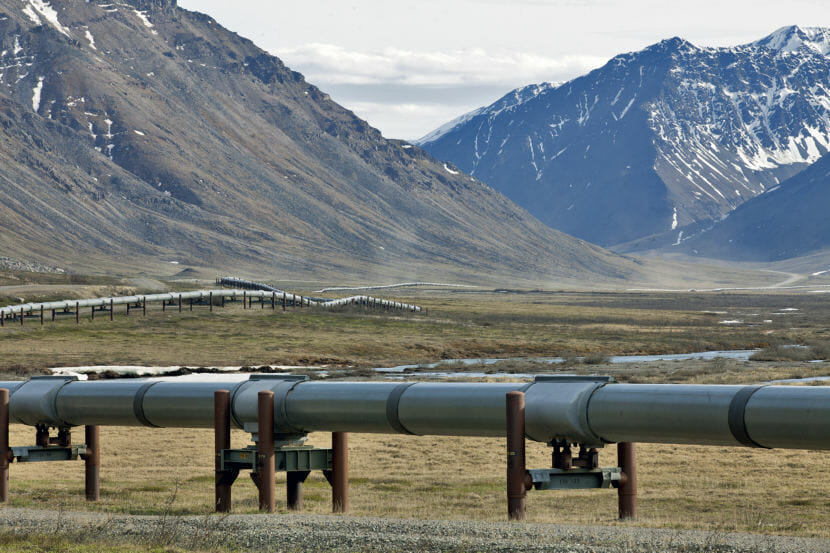
Updated story — April 10, 2020
Pick one: a pizza or a barrel of Alaska North Slope crude. For less than $20, you could have had either one Tuesday.
Prices have rebounded since then– sort of. Now you’d have to buy a pizza and a cheap six-pack before you got into the $25-ish range where Alaska North Slope Crude is hovering now. None of this is exactly ideal for Alaska’s bottom line.
What happened? The $18.21 price per barrel was a mistake. The Department of Revenue has revised it’s report and that price bumped up to $24. But state analysts are expecting prices to drop into the teens next week.
Dan Stickel, Alaska’s chief economist, says there are a few reasons why prices are so low right now.
The first is supply: There’s too much oil on the global market. Russia and Saudi Arabia stopped limiting their production and the price war between the two countries has triggered a major drop in the price of oil.
The second is demand: The COVID-19 pandemic has upended everything. In a time of social isolation and quarantine people just aren’t driving or flying as much as they used to. The U.S. Energy Information Administration reported this week that gasoline consumption could go down by 25% in the next few months. And that it could take 18 months for domestic fuel demand to return.
And, there’s another wrinkle in the supply chain: There’s less demand on the West Coast refineries that process Alaska’s oil. But even if they wanted to produce more, Stickel says they have other problems.
“We’ve heard of coronavirus infections in the refineries that are reducing their ability to work,” he said. “Everyone’s sick with coronavirus; you can’t refine oil.”
There’s another reason for that sudden price drop, but is a bit tricky to pin down because there aren’t a lot of details about exactly what happened.
There is no spot price for Alaska North Slope Crude. Instead, the daily prices are estimated by comparing it to these other types of crude.
“The way that the oil market works is there’s benchmark crude which are widely traded crudes with a known location and quantity and quality,” said Stickel.
West Texas Intermediate has been the most followed benchmark crude in the Americas for a long time. Another one is Brent Crude, which comes from the North Sea. The state compares Alaska’s crude to that one a lot because they’re similar types of crude and they’re transported the same way.
So when people buy and sell Alaska’s crude they do it against these benchmarks. And there are assessment services that monitor all of the transactions and then they publish estimates of the prices for some of the lesser traded crudes like Alaska’s.
What happened when we ended up at $18 per barrel is that someone, somewhere sold some Alaska North Slope Crude at a huge discount, dragging the price down.
But, we’ll probably never know who did that, or why. Stickel says that information is typically held pretty tightly.
What is clear is that there is a ton of volatility in the oil markets right now and because Alaska North Slope Crude prices are estimated this way, it’s getting harder for assessment services to figure out the clear value of Alaska’s oil. So, we can expect to see prices jump up and down for a while.
Original story — Published April 9, 2020
Alaska North Slope oil prices tumbled to $18.21 a barrel on Tuesday.
On Wednesday, economists at the state’s Department of Revenue were working to identify what drove the price down and what they could expect going forward.
Chief economist Dan Stickel says there are a few reasons why prices dropped that quickly.
First, there’s a glut of oil on the global market. Russia and Saudi Arabia stopped curtailing their production. The price war between the two countries has triggered a major drop in the price of oil. That glut also means that Alaska North Slope crude is seeing new competition in the West Coast markets it traditionally serves.
Second, the COVID-19 pandemic has caused a huge drop in demand. In a time of social isolation people just aren’t driving or flying as much as they used to. The U.S. Energy Information Administration put out a forecast on Wednesday that showed a 25% decline in motor fuel use in the first quarter of 2020. That decline is expected to continue.
Stickel says refineries on the West Coast are also producing less, in part because many refinery workers are sick with COVID-19.
He hopes this is a temporary drop and that prices will rebound to what the Department of Revenue forecast on Monday. But that report has oil prices expected to stay under $30 a barrel through June.
This is a developing story. Check back for updates.
Correction: A previous version of this story said oil prices tumbled on Monday — they fell to $18.21 on Tuesday.
